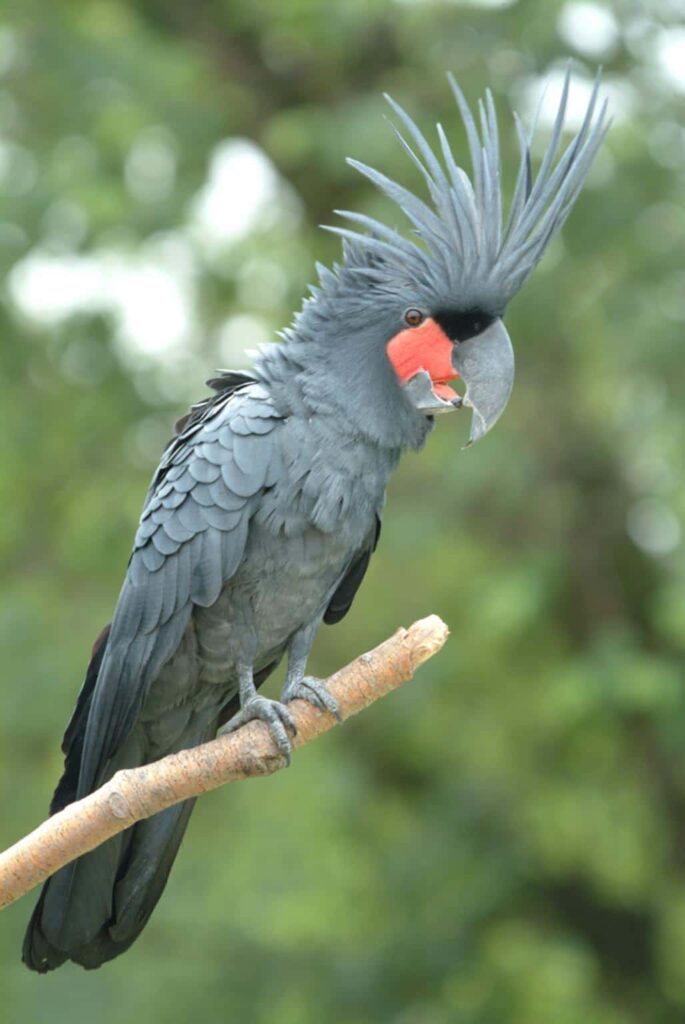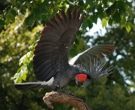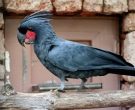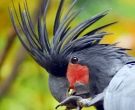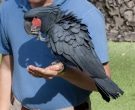Content |
|---|
Description
51 to 64 cm. height and a weight between 910 and 1200 g.
The Palm cockatoo (Probosciger aterrimus) it is one of the largest cockatoo species. Unmistakable with a Erectile Crest of 15 cm.. Mainly arboreal.
Both sexes differ in size. Immatures are differentiated by the pale yellow at the bottom and the tip of the bill and the eye ring in color white.
Usually black with a bare area around the cheeks and eyes red. The feathers of the crest they are long and thin, black streaks.
The bill is dark gray, smaller in the female. The legs son grises. The language is black and Red.
The cheek skin changes color according to its health or stress level, a pink / beige to a yellow when it is excited.
Description 4 supespecies
-
Probosciger aterrimus aterrimus
(Gmelin, 1788) – Nominal.
-
Probosciger aterrimus goliath
(Kuhl, 1820) – Larger than the subspecies macgillivrayi.
-
Probosciger aterrimus macgillivrayi
(Mathews, 1912) – Larger than the species nominal.
-
Probosciger aterrimus stenolophus
(Oort Cloud, 1911) – As the subspecies goliat, but with feathers crest closer.
- Sound of the Palm cockatoo.
Habitat:
The presence of this cockatoo is documented from sea level to 1350 metres in height.
In New Guinea they are in tropical rainforests, including gallery forests, edges of forests and monsoon forests. In Australia they live in forests of eucalyptus, forest of Melaleuca, partially cleared areas and sheets.
You are travelling individually, in pairs or in groups of five or six. About an hour after sunrise they gather in the treetops.
Reproduction:
The nesting occurs between August and February.
Nest in the cavities of trees which tend to be of approximately 1 m depth and 25 to 60 cm in diameter. These are full of branches broken at the bottom on which rests the egg. The site is often used year after year.
Reproduce every two years. They put a single egg and both parents the hatch for a period of 28 to 31 days, at around 3 to 4 more days to hatch. The squab was born completely naked and does not develop marker, unlike other Cockatoo chicks. They are taken from 100 to 110 days to leave the nest, the longest period among all parrot species. After leaving the nest, the young bird depends on the parents at least others 6 weeks because of its inability to fly.
Food:
Seeds, dried fruits, fruit, berries, sprouts leaves and insect larvae.
They feed mainly in the forest canopy, but can also feed on the ground on fallen fruits and seeds.
Distribution:
Size of the area of distribution (reproduction / resident): 716.000 km2
New Guinea and adjacent islands, North of Queensland, Australia.
Distribution 4 subspecies:
-
Probosciger aterrimus aterrimus
(Gmelin, 1788) – Nominal. Islands Aru, Misool, South of New Guinea and northeast of Australia (Cape York)
-
Probosciger aterrimus goliath
(Kuhl, 1820) – Western Cordillera Papuan Islands, except Misool, Indonesian, and centre of New Guinea, since the Doberai Peninsula, Irian Jaya, up to the this of the southeast of Papua New Guinea.
-
Probosciger aterrimus macgillivrayi
(Mathews, 1912) – South of New Guinea between the rivers Fly and Balim, and Cape York Peninsula, North of Queensland, Australia, on the East Coast towards the Princess Charlotte Bay and on the West Coast, in the edward river.
-
Probosciger aterrimus stenolophus
(Oort Cloud, 1911) – The Yapen island on Cenderawasih Bay, Irian Jaya, and North of New Guinea, from the mamberamo river to the East of the collingwood bay, Southeast of Papua New Guinea.
Conservation:
State of conservation ⓘ |
||
|---|---|---|
 Minor Concern ⓘ
(UICN)ⓘ
Minor Concern ⓘ
(UICN)ⓘ
| ||
• Least concern according to IUCN classification.
• Population trend: Decrease
This species has a very large range, and therefore not approaching the threshold of vulnerability. While the trend of the population seems to be decreasing, the decline is not believed to be fast enough to approach vulnerable bird thresholds based on population trend criteria.
In some parts of its area of distribution, the forest habitat in which occur the hollow trees is being invaded by the rainforest.
"Palm cockatoo" in captivity:
Rare bird cage, Although they have a great demand for the market of pet due to its unusual appearance.
They can live more than 55 years of age in captivity.
They may develop compulsive behaviors, as the pecking of feathers. They can also mimic sounds and human language.
Aggressiveness within pairs is taken into account for captive breeding., Sometimes the male usually kill the female. As such, There are more different management methods, from bringing both cockatoos together only during the breeding period and quickly removing the male, cut the male that the female escape flying, or create complex installations that are carried out next to a cutout of the male, so that the female always has an escape route in the face of aggression.
There are currently laws that prohibit the export of any Palm cockatoo without a permit.
Alternative names:
– Palm Cockatoo, Black Macaw, Goliath Aratoo, Goliath Cockatoo, Great Black Cockatoo, Great Palm Cockatoo (English).
– Cacatoès noir, Microglosse noir (French).
– Arakakadu (German).
– Cacatua-das-palmeiras (Portuguese).
– Cacatúa de las Palmas, Cacatúa Enlutada (español).
scientific classification:
– Order: Psittaciformes
– Family: Cacatuidae
– Genus: Palm
– Scientific name: Probosciger aterrimus
– Citation: (Gmelin, JF, 1788)
– Protonimo: Psittacus aterrimus
Images of the Black Cockatoo:
Sources:
– avibase
– infoexoticos
– Parrots of the World – Forshaw Joseph M
– Parrots A Guide to the Parrots of the World – Tony Juniper & Mike Parr
– Birdlife
– Photos: avianzoo, papageien.org, avianzoo, Wikimedia.org
– Sound: Frank Lambert
